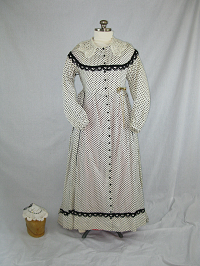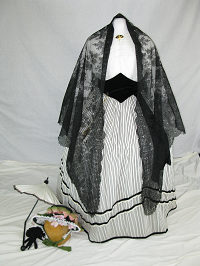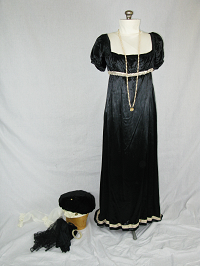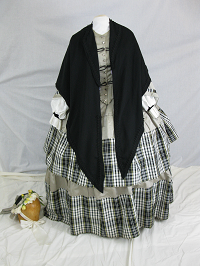
- Details
- Category: 19th century
- Hits: 2487
1862-1865
The Civil War caused an expansion of industrial developments especially in shoes and textiles. New methods of merchandising such as men’s ready made clothing brought about a more rapid change in fashion. The gored skirt replaced the many gathers and the silhouette became more angular. The skirt hem which had been even, now ended in trains for daytime as well as for evening. (No. In 1862-63, the Black and White Mania struck.) Nellie is wearing a spotted cotton summer day dress. By the end of 1863 the waist line had become quite high and on some gowns was nonexistent. Called “En Princesse” this gown’s bodice and skirt is one piece. The dropped shoulder line has returned to its proper place and the satin sleeve is shaped at the elbow. To hang well over the new shaped crinoline, the skirt’s fullness is box pleated into the seams. Pockets are back but have been attached to the front seam. The handerkerchief is in the pocket not in the hand. Hairdos became more important than bonnets. Chignons, made from added hair, were introduced in Paris, and became popular in the US for indoor wear. Over these were worn crocheted or knitted and beribboned caps.
Gowns in the fashion magazine illustrations were highly trimmed but Mr. Godey stated it was up to each woman to decide what and how much trimming suited her and her station in life. This gown has a looped braid to form a yoke on the bodice and edge the hem. Piping was used on the skirt seams to accent the new triangular shape. But now instead of sewing it in the seams it is sewn on the top. The 24 buttons down the front are just decorations as the gown is closed with hooks and eyes. To keep them from becoming unhooked they are sewn on alternatingly. The high neckline has a hand crocheted collar.
Fashion permitted a woman to loop up the trained skirt while walking in dirty streets. This necessitated a pretty petticoat. Bright colored merinos with scarlet were preferred, and were made possible by the discovery of aniline dyes. “Caged” petticoats were much reduced at the top but they became larger on the bottom. The gentlemen enjoyed the flatter front. Some hoops had concealed strings that when pulled made it possible to ascend stairs. The crinoline was worn by all classes. It caused havoc in factories, especially where they made china and glass, as the large skirts swept objects off of shelves. In strong winds, wearers could be blown off their feet. The more serious danger was from fireplaces. The wire frame made it impossible to wrap a burning skirt in order to smother the flame.
Tight lacing persisted but was less extreme because the large skirts gave the illusion of a small waist. Corsets were now made by joining separate pieces instead of adding gussets. White was most elegant, but gray, putty, red, and black more serviceable. Drawers consisted of two separate sections sewn on a waistband. They were therefore open below the waist and overlapped in the back.
Stocking colors varied from white to black. The 1860s saw black stockings and the beginning of modern shoes. Manufactured shoes could be bought in stores, in pairs, one for the right and one for the left foot, for the first time. The popular boot was tightly laced up the side.
This outfit was made by Nellie Wright.
Click photo for detailed views.
- Details
- Category: 19th century
- Hits: 2706
1825
As the classical lines grew more angular, firmer materials were needed. The popularity of silk, satins and velvets grew in the 1820s. Gowns were also stiffened by applied decoration around the bottom. This pale blue velvet evening gown was designed from a picture in Ackerman’s Costume Plates of 1825. The corsage is plain across the bust, and drawn to shape with a little fullness at the waist. Falling rather low on the shoulders, the neckline is finished with embroidered lace. The sleeves are short with epaulettes formed of heart-shaped leaves and trimmed with blond lace. Full white silk is gathered with a satin band for the bottom of the sleeves. At the bottom of the skirt is a broad band of satin with small silk cord laid across forming squares. An embroidered ceinture (belt) is fastened in front with an antique gem. The African turban of satin, velvet and embroidery was worn for formal occasions. Short white gloves are worn with the long sleeves.
Click photo for detailed views.
- Details
- Category: 19th century
- Hits: 2726
1860s
In the early 1860s the black and white craze hit. This outfit consists of a white body and striped skirt. The introduction of the separate bodice made possible using the same skirt for both day and evening. The large skirts and sleeves made outdoor wear a problem solved by capes, dolmans, and shawls. Lace gave the effect of a submissive woman. Bonnets were the only acceptable form of head covering for an older woman. Parasols with folding handles made them more convenient. Fingerless mitts could be worn even while taking tea.
Elaborate petticoats could be kept in order by wearing them looped up over a pretty petticoat. Some had bright colors with velvet or embroidered trim. Skirt lifters raised the hem of the skirts from the dirt. The large skirts were also hazardous indoors, especially around the fireplaces. Regular accounts in the newspapers told of the untimely deaths of women whose light muslin garments caught fire. Fashion magazines printed methods of fire proofing these filmy gowns. The hoops made it nearly impossible to extinguish the flames should a woman’s dress catch on fire. But wearing a hoop was delightfully easy and cool compared to the heavy bulk endured by wearing four or five petticoats. Only one petticoat was needed beneath the hoop. The hoop caused women to adopt a masculine item of clothing - the drawers.
This plain gathered skirt, white with black stripes, is decorated with black velvet and galloons of heavy lace. The narrow black velvet binding around the bottom protects the hem and could be replaced when it became worn. A body (or blouse) made high at the neck with a shirred yoke, known as a Garabaldi, and could be worn with different skirts. Large puffs of silk, shirred into a narrow cuff, compose the “Bishop” sleeve. To emphasize the small waist, a black velvet “Medici” girdle was worn. The editors of Harper’s Bazaar commented “what can be more disagreeable than to see a lady’s skirt sweeping the street as she walks.”
The 1850s saw the opening of the department stores where machine made lingerie could be purchased. The sewing machine made possible more and more trimming. The expansion of wealth gave birth to a greater display by the growing middle class. Travel fever struck and months were spent planning the trip to the seaside or mountains. The first things to think about were the multitude of underclothes required. No lady would be without a wool vest next to the body to absorb perspiration even though her activities were restricted so she should not perspire. By now the drawers had evolved into split seat knee length affairs. The chemise has shrunk to hip length. The corset confined and molded the figure into the shape dictated by the fashion of the day. During the 1860s and 70s a girl of 16 should have a 20 inch waist and a woman of 20 should have a 16 inch waist. Several actresses had their floating rib removed so the waist could be drawn into those dimensions. The corset was put on damp one hour before dressing.
Click photo for detailed view.
- Details
- Category: 19th century
- Hits: 2625
1809
Ever since they became an institution in the late 18th century, fashion plates continued to illustrate the latest modes. Two French magazines provided the inspiration for this black velvet evening gown from 1809. The flowing classical line of the early years has begun to straighten and grow more angular. The Greek key braid adds interest along the hemline accentuating a small train. Gold and silver trim were used on evening wear.
A new form of construction was introduced around 1800 with the bodice fastened at the center back. By 1810 the stomacher was obsolete. Classical lines were preserved by wearing long shawls and scarves for warmth, especially by the fashionable, who wore their dresses very low and their sleeves very short. A great deal of practice and dexterity were essential for the well “draped” woman. The first “kashmir” wool shawls were sent from Egypt by Napoleon to Josephine. They were expensive but soon were imitated by manufacturers in France and Scotland. The archaeological excavations of Pompeii, an Italian city buried by a volcanic eruption in AD 79, influenced jewelry designs with classical Greek and Roman elements. Hair was worn short and curled, and was topped with a fanciful turban for evening wear, such as this one of black velvet and satin and trimmed with ostrich feathers and jewels.
Footwear underwent great changes after the American Revolution. High heels disappeared and flat soles were worn. Many were so wide they had to be kept on by ribbons tied up the leg.
Most under clothing pads and corset had been cast off after the French Revolution. An important innovation in this period was the introduction of drawers for women. Drawers reached to just below the knee. Elastic cotton drawers are advertised in 1806. Since rubber elastic had not been invented yet we can only conclude these were knitted drawers. As with most new fashion, they were initially limited to the upper class and considered a status symbol. The scanty dresses could no longer conceal the pocket hung around the waist, so they were replaced by a small handbag, called a reticule, or “indispensable.”
Click photo for detailed views.
- Details
- Category: 19th century
- Hits: 2664
1850s
This gray silk carriage dress is a copy of an original gown in the London Museum that was made in the late 1850s. It was pictured in the book, “Cut of Women’s Clothes” by Norah Waugh. For outdoor wear we have added the latest creation from New York, a spring bonnet of black crepe, arranged on a foundation of lace. The front is edged with a double fold of gray silk. Yellow flowers adorn the right side and yellow roses are interspersed in the full cap of blond lace. On the left side is placed a gray silk bow trimmed with pearls. The curtain, to protect the neck from the sun, is of the same silk. The broad riband streamers tied beneath the chin were called brides. Remodeling of dresses to keep in style was practiced extensively. One magazine recommended that large shawls be made to match the gown so it could be used in future remodeling.
The bodice of the gown is decorated with braid froggings and silver buttons. Men’s uniforms are the most likely inspiration for this ornamentation, and also the stripes on the sleeves. Under the pagoda sleeve can be seen large detachable sleeves of batiste which tend to make the hands disappear. The basque bodice is fully lined and boned on all seams. The flounces of the gown have wide bands of plaid taffeta, the skirt is completely lined, and also has a 10-inch band of stiff muslin to give body around the bottom. It is pleated in the front and gauged (or gathered) in the back.
The many petticoats of the 1840s have been laid aside for a new invention - the hoop. The hoop was not accepted without some ridicule. The hoop supported the weight of this gray pure silk tiered skirt. The skirt is fully lined and has a 10-inch band of stiff muslin, which gives body around the bottom. The detachable sleeves of batiste, which are long and full, make the hands seem to disappear. Small hands were the sign of gentility. The “basque” bodice is fully lined and boned on all seams. Men’s uniforms are the most likely inspiration for the braid froggings and silver button ornamentation of the bodice.
Click photo for detailed view.
Page 5 of 13





